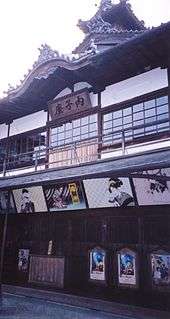Uchiko, Ehime
Uchiko (内子町, Uchiko-chō) is a town located in Kita District, Ehime Prefecture, Japan.
Uchiko 内子町 | |
|---|---|
Town | |
Flag | |
 Location of Uchiko in Ehime Prefecture | |
 Uchiko Location in Japan | |
| Coordinates: 33°32′N 132°39′E | |
| Country | Japan |
| Region | Shikoku |
| Prefecture | Ehime Prefecture |
| District | Kita |
| Area | |
| • Total | 299.50 km2 (115.64 sq mi) |
| Population (April 1, 2017) | |
| • Total | 16,172 |
| • Density | 54/km2 (140/sq mi) |
| Time zone | UTC+9 (JST) |
| City hall address | 168 Kō, Hiraoka, Uchiko-chō, Kita-gun, Ehime-ken 795-0392 |
| Website | www |
On January 1, 2005, the town of Ikazaki, from Kita District; and the town of Oda, from Kamiukena District, were merged into Uchiko.
As of April 1, 2017 (after this merger), the town has an estimated population of 16,172 and a density of 54 persons per km². The total area is 299.50 km².
Overview
The traditional town of Uchiko is located about 42 kilometers southwest of Matsuyama in the Ehime Prefecture. Three streams run through the area: the Oda, the Nakayama and the Fumoto. Uchiko has few flat areas and about 70% of the land is forest. The soil is fertile and the main industry is agriculture, particularly leaf tobacco, shiitake mushrooms, and fruits such as persimmons, grapes and nashi pears. The riversides are used mainly by farms and farmland can extend to the hills and the steep mountainsides. As of April 2005, the population in Uchiko was approximately 20,650.
From the end of the Edo period (1603–1867) to the end of the Meiji period (1868–1912), Uchiko developed and thrived as a manufacturing center of Japanese paper and Japanese wax. At that time the Yokaichi and Gokoku districts became industrialised and their historical houses still retain some vestige of Uchiko’s former glory. In the Yokaichi and Gokoku districts is a street of merchant houses, which have solemn white or cream coloured plaster walls, lattices, decorative walls and old-style Japanese desks. This traditional street is about 600 meters long and around 90 of these historical houses are still lived in. The campaign to preserve this old town area has been ongoing since 1975 and the national government designated this area as an "Important Traditional Construction Preservation Area" in 1982.
The Nobel laureate Kenzaburō Ōe was born in Uchiko.
Uchiko Theatre
The Uchiko-za was built as a traditional Kabuki theatre in 1916 and was famous for its Kabuki and Bunraku (traditional puppet show) performances. In the course of time, it became used for film shows, variety shows and lectures, amongst other things. In 1985, the theatre was restored to its original appearance. Today, Uchiko-za presents plays, concerts and other events, including the very popular Bunraku performances. The Uchiko-za is unique and traditional because of its open Taiko-drum tower, the boxed seating area, the broad ramp leading to the stage along one side of the audience and the wooden, revolving stage. The Uchiko-za is considered a showpiece of Japanese culture and architecture.
The Kamihaga Residence and Japanese Wax Museum
The Kamihaga Residence was built in 1894 by a family who were a branch of the Honhaga household (the main household in Uchiko). The Kamihaga family was one of the most influential families in Uchiko. They established the production of wax in Uchiko and thus, the family became very wealthy and powerful. Now, this elegant and traditional property, with its spacious garden, is used a museum that has exhibitions on commerce, the lifestyle of the merchants and the production of wax. These grounds are designated as an Important Cultural Property and have been since 1990.
Annual events
- Late April: The Raft Festival at the River Oda, Oda.
- May 5: The Kite Flying Festival in Ikazaki.
- Late May – Early June: Rice planting in Ikazaki.
- August 6–8: The Bamboo Festival in Uchiko.
- August 15: The Fire Festival in Oda.
- October: The Autumn Festival, The Japanese Lion Dance.
- November: Momiji – Autumn leaf viewing.
- December: Solfa Ski Resort opens in Oda.
Sister Cities
Gallery
- Merchant's Residence
- Side Street in Uchiko
External links

- Uchiko Town International Association
- Uchiko official website (in Japanese)
